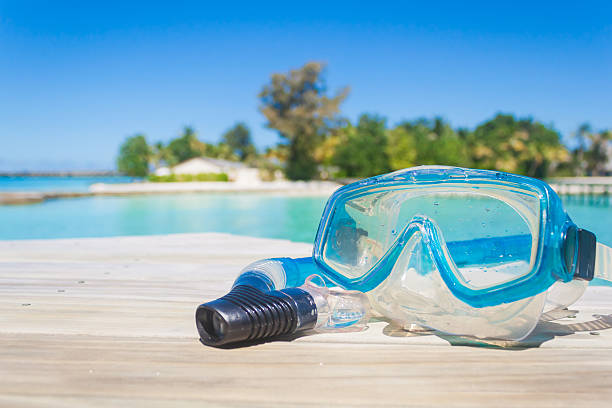There is little in diving more frustrating than a mask that fogs. That blurry screen instantly breaks your connection with the underwater world, turning a vibrant reef into a hazy, indistinguishable mess. As a professional in the diving gear industry, I know this struggle intimately. Mask fogging isn’t just an annoyance; it’s a distraction that compromises safety and ruins the dive experience.
The good news? It is entirely preventable. Achieving truly fog-free dives requires understanding the science, mastering a crucial preparation step, and applying consistent anti-fog techniques. This comprehensive guide, built on years of industry experience, walks you through every effective solution, from preparing a brand-new mask to executing a quick fix at depth.
Why Do Diving Masks Fog Up?

To conquer fog, we must first understand the enemy. The fog you see is not smoke or dirt; it is a simple physical phenomenon called condensation.
The Mechanism:
- Warm, Moist Air: When you dive, the air inside your mask is warmed by your face and lungs. Since you exhale through your regulator, your nose contributes warm, extremely moist breath.
- Cool Surface: The water surrounding your mask’s lens (the tempered glass) is significantly cooler than the air inside. For example, in many temperate waters, the water temperature might be 20℃ (68℉), while the air inside is closer to 30℃ (86℉).
- Condensation Point: When the warm, moist air inside the mask meets the cooler glass surface, the moisture instantly cools and transitions from a gas (water vapor) back into a liquid (water droplets).
These microscopic water droplets cling to the lens surface. When they are tiny, they scatter light, creating the opaque, cloudy effect we call “fog.” The key to an anti-fog solution is to disrupt this process, usually not by stopping the condensation, but by preventing the water droplets from scattering light.
The Crucial First Step: How to Treat a Brand-New Dive Mask
The biggest single factor contributing to persistent fogging in new masks is not condensation itself, but an invisible residue left over from the manufacturing process.
During production, a thin layer of silicone residue (sometimes called a mold-release agent or film) is deposited on the inner surface of the tempered glass lens. This film is highly water-repellent. When water vapor condenses on it, the water beads up into large, light-scattering droplets, making the fog incredibly dense and stubborn. No amount of standard defog spray will work until this layer is removed.
We recommend one of two highly effective methods for this one-time preparation:
Method A: The Toothpaste Polish
This is the gentler and safer method, suitable for virtually all masks, including those with expensive coatings or integrated lenses.
- Material: Use a standard, non-gel toothpaste (the white paste type) that does not contain abrasive crystals, microbeads, or whitening agents.
- Application: Apply a small amount of toothpaste to the inner lens surface.
- Rubbing: Vigorously rub the toothpaste into the glass using your finger, focusing on the entire surface area. Treat it like polishing a fine piece of silverware. Continue this scrubbing action for at least five minutes per lens.
- Rinse: Rinse the mask thoroughly with clean water.
Method B: The Lighter Flame (Use with Extreme Caution)
This method is fast and highly effective for standard tempered glass but carries a slight risk of damaging the silicone skirt if not executed correctly.
- Ventilation: Work in a well-ventilated area.
- Application: Using a standard lighter, hold the flame near the inner surface of the lens. The goal is to apply just enough heat to burn off the organic silicone residue.
- Observation: You will see a layer of black soot forming on the glass. Move the flame constantly to cover the entire lens surface. Do not let the flame touch the silicone skirt.
- Cleaning: Once the entire lens is sooted, let it cool completely. Wipe the soot away with a soft cloth or tissue, then clean the mask again with toothpaste or soap and water. The glass should now be perfectly clean and no longer repel water.
Примечание: This is a one-time treatment. After this preparation, you can rely on the common anti-fog methods detailed below.
Visual Reference: For a step-by-step demonstration of both the initial lighter treatment and the toothpaste application, you can view this comprehensive guide:
Effective Anti-Fog Methods You Can Use Before Every Dive

Once the initial factory residue is gone, the subsequent fogging is purely from condensation. To combat this, we rely on surfactants. A surfactant is a substance that reduces the surface tension of a liquid. When applied to the lens, it causes the condensing water vapor to form a thin, uniform sheet of water instead of individual droplets. Since a thin sheet of water doesn’t scatter light, you get clear vision.
Here is a comparison of the three most popular methods:
| Anti-Fog Method | Cost/Availability | Effectiveness | Primary Drawback | User Profile |
|---|---|---|---|---|
| Human Saliva (Spit) | Free / Always available | Moderate-to-High | Varies by individual, less hygienic, washes off quickly. | Budget-conscious, impromptu diver. |
| Baby Shampoo Solution | Low / Widely available | High | Requires mixing, potential eye irritation if formula is wrong or residue is left. | Consistent, prepared diver. |
| Commercial Anti-Fog Spray | Moderate / Dive shops | Very High | Higher cost, must be purchased, can be messy if overused. | Professional, high-performance diver. |
Expert Recommendation: The Baby Shampoo Method
Diluted tear-free baby shampoo is consistently rated by professional divers as the best balance of cost, availability, and effectiveness. Use a simple 1:1 or 1:3 dilution (shampoo to water) in a small drop bottle for easy application. The gentle formula significantly reduces eye irritation compared to standard soaps or dish detergents.
How to Apply Anti-Fog Correctly for Maximum Results
The application method is just as critical as the product you choose. Even the best commercial defogger is useless if applied poorly.
Step-by-Step Application:
- Apply to a Dry Lens: Ensure the inner lens is reasonably dry and clean. Any large dirt particles should be rinsed off first.
- Use Sparingly: Whether using spit, shampoo, or commercial spray, apply only a small drop or two to each lens. For baby shampoo, a single drop per lens is often sufficient. Do not flood the mask.
- Rub It In: Use a clean finger to gently, but thoroughly, rub the solution across the entire inner glass surface. Ensure the solution coats every millimeter of the lens, especially into the corners and edges. You are establishing the surfactant film.
- The Critical Rinse: This is where many divers fail. You must rinse the mask just enough to clear the visible residue, but not enough to wash away the invisible surfactant film. A quick, single dunk in the water (fresh or salt) is usually ideal. Do not hold the mask under running water or agitate it vigorously; this will strip the necessary residue.
The ideal outcome is a lens that looks perfectly clean and transparent, yet still holds a microscopic layer of the anti-fog agent. This layer will now manage condensation effectively.
Quick Fixes for Mid-Dive Fogging: What to Do Underwater

Despite the best preparation, fogging can occasionally occur mid-dive, often due to a slight leak introducing fresh water, or perhaps an unexpected shift in water temperature. Panicking is unnecessary. Here is the mask-clearing technique, which helps you restore clear vision and stay focused underwater.
When you are in mid-dive:
- Notice the Fog: If a persistent blur appears, pause your activity briefly.
- Introduce Water: Allow a small amount of water to enter the mask. Tilt your head forward slightly and depress the upper rim of the skirt to let water seep in and collect at the bottom.
- Swirl the Water: Gently move your head side-to-side and up-and-down. The water you just introduced acts as an on-the-spot solvent. This swirling action redistributes the residual surfactant and wipes the condensation film away from your line of sight. Think of it as an internal windshield wiper.
- Clear the Mask: Look up, press the top of the mask firmly against your forehead, and exhale slowly through your nose. The air will displace the water through the bottom skirt.
- Resume Dive: The lens should now be clear.
This method effectively combines a physical wipe with the surfactant-coated glass, clearing the immediate visual obstruction and buying you more fog-free time.
Long-Term Strategies: Cleaning, Maintenance, and Storage Tips
Proper post-dive care is crucial for maintaining the integrity of your mask’s materials and setting the stage for the next fog-free dive.
Post-Dive Cleaning:
- Rinse Immediately: Saltwater crystals left to dry on the lens can create microscopic etchings, attracting fogging. Within an hour of surfacing, rinse your mask thoroughly in fresh, clean water.
- Deep Clean: Every 5-10 dives, give the mask a mild deep clean using a gentle, non-abrasive dish soap to remove accumulated salt, sunscreen, and oils from the face. Pay special attention to the silicone skirt, which can become stiff and leak if neglected.
Storage:
- Avoid Heat and Sun: Never store your mask in direct sunlight or exposed to high heat (like the dashboard of a car). UV light and heat degrade the silicone skirt, causing it to harden, warp, and potentially create micro-leaks—which, in turn, introduce water and prompt fogging.
- Use the Case: Always store the mask in its original protective plastic box or a padded gear bag. This prevents scratches on the lens (which again, attract fogging) and protects the skirt from being crushed and misshapen.
Choosing the Right Gear: Does Mask Quality Affect Fogging?
While your preparation is the ultimate solution, certain mask features can influence the severity and frequency of fogging.
Fit is Paramount
A well-fitting mask is one that doesn’t leak. Leaking allows fresh, cold water to be constantly introduced, which rapidly cools the glass, increasing the condensation rate. A comfortable, deep-sealing silicone skirt minimizes water entry and better maintains the internal micro-climate.
Lens Materials
Tempered Glass: This is the industry standard and is what we have discussed exclusively. All tempered glass requires the initial anti-residue treatment.
Plastic/Polycarbonate: Found in some snorkeling or very basic masks. This material scratches easily, and those scratches create fog nucleation points, making them generally more prone to fogging over time.
Skirt Color and Type
The primary difference between clear and black/colored silicone skirts is light refraction, not fogging. However, a clear silicone skirt often makes the fog more visually distracting because it allows light to enter from the sides and highlight the condensation. A black silicone skirt typically blocks peripheral light, making the condensation less noticeable to you.
Заключительные мысли
Ultimately, a 200 high-quality mask will fog up just as quickly as a 50 entry-level mask if you skip the crucial initial factory-film treatment. The difference lies in the quality of the seal and the durability of the materials. Invest in a mask that seals perfectly to your face; the anti-fog solution remains your personal responsibility.
If you’re looking for a reliable supplier of high-quality anti-fog diving masks, Авангард Плавание is a trusted option. With over 30 years of experience in swimming and diving gear, Vanguard offers durable materials, comfortable silicone skirts, and lens technologies designed to minimize fogging and leakage.
Ready to upgrade your gear and keep your mask fog-free?
Свяжитесь с нами сегодня to get professional support and gear that fits you and performs reliably.


